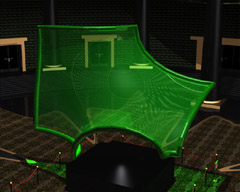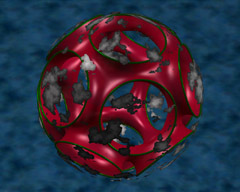|
|
Touching Soap Films |
|
|
|
Scenes from the Video IIISymmetry Properties
Minimal surfaces have two important symmetry properties elaborated in the sequence 'Symmetry'. If a surface contains a straight line then it can be extended to a larger minimal surface by rotating a copy around the line by 180°. The two pieces fit smoothly at the line. Furthermore, minimal surfaces can be reflected at symmetry planes. Symmetry properties have been essential for the construction of most known minimal surfaces. Nearly all minimal surfaces shown in the video contain symmetry lines which made it possible to construct only a fundamental piece for the symmetry group. The full surface was then generated by reflection. Triply periodic surfaces play a major role for crystallographic applications, since they divide three-dimensional space into two disjoint regions, three dimensional labyrinths. The sequence 'Cyber Space' gives a glimpse of life inside such labyrinths. Surfaces in Hyperbolic Space
The mathematical investigation of minimal surfaces had its physical origins in a legacy from a remote realm-a soap film spanned by a wire loop. The minimal surface in hyperbolic space shown in Fig 22, found by Konrad Polthier cannot be regarded as a soap film, not only because it extends to infinity, but also because it exists in an unusual mathematical space: - hyperbolic space - in which the sum of the angles of a triangle is always less than 180°. In the video, hyperbolic space, which extends infinitely, is projected into the interior of a sphere. Parts that are closer to the sphere experience increasingly greater shrinkage in this projection. |

